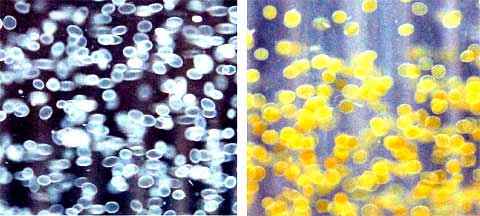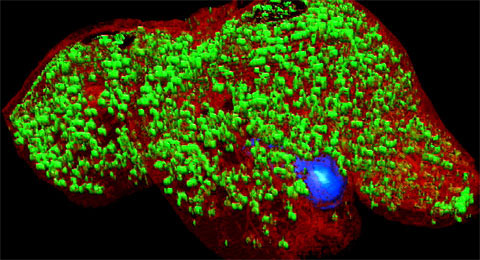| Posted: November 12, 2007 |
Nanoparticle-embedded microcapsules hold promise for multiple medical uses |
|
(Nanowerk News) Jeff Bulte believes good things come in small packages—very, very small packages.
|
|
Bulte, a Johns Hopkins University faculty member affiliated with the Institute for NanoBioTechnology, and several of his colleagues have developed an incredibly versatile micro-scale capsule embedded with nano-sized particles able to enhance real-time visualization with magnetic resonance imaging (MRI) as well as deliver a powerful therapeutic punch to diseases in animal models.
|
|
“Nanotechnology is becoming much more translational in humans for diagnosis and treatment and for combinations of the two,” says Bulte, a professor in the department of Radiology at the Johns Hopkins School of Medicine and in the department of Chemical and Biomolecular Engineering in the Whiting School of Engineering.
|
 |
| (left) Unlabeled alginate capsules; (right) Alginate capsules labeled with Feridex, or ”magnetocapsules” (note ferric oxide rust brown color). (Image: Bulte Lab/JHU)
|
|
Magnetic microcapsules made of a seaweed extract and ferric oxide and filled with human insulin islets safely produced therapeutic levels of insulin in swine for up to four weeks. Bulte, together with Johns Hopkins colleagues Brad Barnett, Aravind Arepally and others, recently reported these findings in Nature Medicine (" Magnetic resonance–guided, real-time targeted delivery and imaging of magnetocapsules immunoprotecting pancreatic islet cells"). By embedding magnetic nanoparticles in a microcapsule just 350 µm in diameter, the nano-particles are concentrated to increase the sensitivity of MR imaging. In addition, the openings in the capsules are large enough to release their therapeutic payload (insulin), yet small enough to prevent the contents from coming under attack by the body’s immune response system.
|
|
The Nature Medicine article describes one way the microcapsules can be made and used. “What’s so exciting is that the capsules remained stable, and they worked the very first time,” says Bulte. “But the capsules are not limited to diabetes; we have plans for other applications with hepatocytes and stem cells,” he adds.
|
 |
| Color-segmented 3D MRI of swine liver following infusion of 40,000 magnetocapsules. The capsules are color coded as green, the liver as red, and the gall bladder as blue. (Image: Bulte Lab/JHU)
|
|
These other applications include targeted treatments for fulminant (complete and sudden) liver failure and myocardial ischemia. By modifying the encapsulation materials—using barium sulfate, bismuth or a perflurocarbon emulsion instead of ferric oxide nanoparticles, for example—researchers can apply more widely available noninvasive imaging techniques, such as computerized tomography, X-ray, ultrasound or fluorine imaging.
|
|
Also, filling the capsule with a different payload may provide a different therapeutic payoff. “For imaging using nanotechnology, the important thing is the payload—you have a lot more bang for the buck and you increase your sensitivity with nanoparticles,” Bulte says.
|
|
Kraitchman, another INBT affiliate, and Bulte also use X-ray visible capsules for stem cell therapy to rapidly enhance imaging of hindlimb ischemia in a rabbit model. The stem cell factors stimulate arteriogenesis to help repair the strained vessels symptomatic of ischemia, Bulte says.
|
|
In an ongoing project, capsules filled with hepatocytes are being injected into the abdomens of swine or mice that had had their liver function dramatically impaired by toxins. “The hepatocytes are working as a sort of artificial organ until the toxin is being cleared,” Bulte says. “This helps bridging the gap during a critical time until the liver can regain function following regeneration.”
|
|
With Arepally, an assistant professor in the medical school’s departments of radiology and surgery, and Tom Link, a graduate student in biomedical engineering, Bulte is working on licensing a medical device that can exploit the properties of the microcapsules in a more specialized way.
|
|
Animal studies also will help address some of the unknowns about the long-term use of nanotechnology, Bulte says. “We are running a year-long project in a swine model that will yield important information as to how long the capsules remain stable and continue to make insulin. We need to look at the histology of the liver and see if there will be any undesirable host responses such as inflammation.”
|


